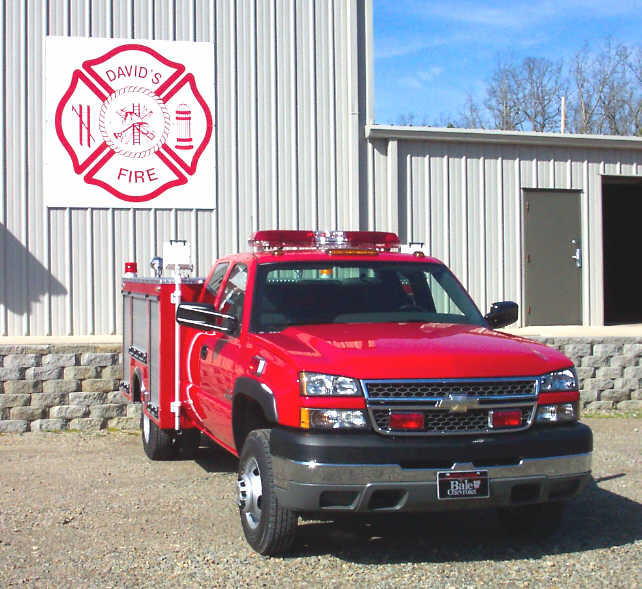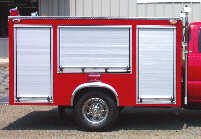LIGHT DUTY WALK-AROUND RESCUE TRUCKS
 Light Rescue trucks are built on the one ton and "Super Duty" chassis of your choice. They are best suited for
dedicated purposes but can carry quite a bit of equipment to back up additional
operations as well. Fire Departments usually purchase light duty rescue
trucks for the following benefits: Light Rescue trucks are built on the one ton and "Super Duty" chassis of your choice. They are best suited for
dedicated purposes but can carry quite a bit of equipment to back up additional
operations as well. Fire Departments usually purchase light duty rescue
trucks for the following benefits:
- Maneuverability
- Turning Radius
- ISO Service Truck Requirements
- Dedicated Use Requiring Minimal Equipment
- 4 Wheel Drive Capability for Off Road Use
(Click Here
to see more pictures of this type of unit.
The linked page will take a while to load.)
Here are just some of the features that set our rescue trucks
apart from the competition!
(Click on the feature for more detail.)
If you take the time to read through the descriptions of our
features that are explained below, you will see that we have taken the time to
carefully design and build this apparatus to the highest quality standards.
It did not start out as chalk lines on a floor or dimensions scribbled down
while measuring somebody else's body. As with all of our products, it
started out as, and continues to be, a labor of love on our part. We truly
want to build the highest quality product we can within a reasonable price
frame.
There are many ways to save money when building fire apparatus
and not all of them are good. Some methods only help the builder and hurt
the customer. We have chosen a different route. The entire apparatus
is designed to be able to build efficiently where it will benefit both us and
our customers. If something might save us on the bottom line but will
adversely affect the quality of the apparatus, it will not even be considered.
Our philosophy is to save the customer money in every way possible without
affecting the quality of the final product.
Further, since we use only stainless steel nuts, bolts and screws,
we will not be wasting your time and our time replacing rusted fasteners on
units under warranty. By only using the highest quality wiring products
and best practice wiring methods, we can avoid the frustrating electrical
problems that plague some customers.
Regarding welding, we subscribe to the old adage, "It takes
less time to do it right the first time than to redo it." Consequently,
all welds are performed by a certified welder. Joints that are intended to
be welded are designed with input from the head welder who is further
responsible for the selection of all gases, wires, consumables, and equipment
used in the welding department.
Aluminum Body
Using aluminum for the primary body material has two distinct advantages to the
customer. First, it is lightweight which translates into greater payload
capacity. Second, it is inherently more corrosion resistant than steel.
Our rescue truck bodies are built from 5052-H32 aluminum sheet that is either 1/8" or
3/16" thick, depending on the function of the particular part. We have
chosen to use this series of aluminum due to its excellent tensile strength vs.
endurance limit characteristics. Nearly every builder who uses aluminum
with break and
bend building practices uses 5052 aluminum for the same reasons.
An additional advantage of using this series of aluminum is
that it is work hardened as opposed to tempered. This means that the heat
created by welding will have a less dramatic affect on the strength of the
material.
With the break and bend process, each part is carefully formed
to maximize usable compartment space while minimizing apparatus weight.
Additionally, our craftsmen have maximum flexibility in design since they are not
forced to adapt a customer's wishes to the structural elements that are the
backbone of their design. Instead, they are free to design primarily
around the customer's desires. Isn't that the way it should be?
Roll-Up Doors
 Roll-up doors are standard. There are many advantages
roll-up style doors offer your department. On rescue style bodies they
have become the standard because they allow full access to the inside of a
compartment. Swing-out style doors can become barriers to personnel using
a truck, especially when there are two compartments that are side by side and
both doors are open. To combat this problem departments have been
installing roll-out trays which are not free. Since the cost of a regular,
hinged door is roughly the same as a roll-up style door, adding roll-out trays
only serves to Roll-up doors are standard. There are many advantages
roll-up style doors offer your department. On rescue style bodies they
have become the standard because they allow full access to the inside of a
compartment. Swing-out style doors can become barriers to personnel using
a truck, especially when there are two compartments that are side by side and
both doors are open. To combat this problem departments have been
installing roll-out trays which are not free. Since the cost of a regular,
hinged door is roughly the same as a roll-up style door, adding roll-out trays
only serves to
 drive
the price of a body up. We are not against roll-out trays, we just feel
that they should not be forced on a customer because of bad apparatus design.
With the roll-up style door, a body can be much more functional for less
expense. drive
the price of a body up. We are not against roll-out trays, we just feel
that they should not be forced on a customer because of bad apparatus design.
With the roll-up style door, a body can be much more functional for less
expense.
Additionally, when swing-out style doors are opened on both
sides of a body, the total vehicle width is dramatically increased. This
may not seem like much of an issue but, rescue trucks are often used on busy
highways or crowded streets where the additional width can put the safety of
personnel at risk by forcing them to walk into traffic or into ditches to avoid
the doors.
No truck is any better than its weakest link. In fire apparatus, that weak
link has proven to be the electrical system. Electrical systems have become
increasingly complex over the years. Even something as simple as a light
bar will now come with a 16 wire harness. Modern options are also
considerably more complex than in the past. To combat that problem, we
chose to start with an engineered system.
In the process of designing the system we attempted to address
the problems that have passed through repair shops over the last ten years.
The electrical system was even addressed in the design of the body components to
keep the system protected as much as possible.
Here are some of the benefits of our engineered electrical
system:
- All loads are switched through relays to accommodate high
current loads,
- Minimum current in wires within the passenger compartment,
- Packard sealed connectors at the connection point of all
serviceable equipment,
- Dielectric compound used in all connectors subject to
weather,
- Automotive GXL type color coded wires with crossed link
polyethylene insulation,
- Heat resistant split loom used throughout,
- SAE Type 1 automatic reset circuit breakers on all
emergency circuits,
- Double crimp wire ends grip conductor and insulation,
- Continuous wire runs,
- Each circuit designed to carry 125% of actual load,
- Less than 5% voltage drop in any circuit wiring,
- And, much more.
Once all major components have been installed and removed, the body is prepared
for paint. The reason to install the components first is to ensure a full
paint film beneath these items. By avoiding masking the body we avoid the
edges caused by masking tape. These edges are a great area for corrosion
to start so we simply eliminate the possibility of them becoming a problem years
down the road.
The entire body is sanded to meet the requirements set forth
by PPG to get maximum adhesion between paint and body material. In fact,
PPG guidelines are carefully followed throughout the entire painting process.
That is why we are capable of extending the PPG 7 year paint warranty to our
customers.
Even though we follow PPG guidelines to the "T" and use the
best quality supplied in the preparation and painting process, problems might
still occur. In fact, Murphy's Law is more at home in the fire service
than any other occupation we are aware of. This is when the value of the
PPG 7 year warranty really can be appreciated. No matter where you live,
there is bound to be a PPG authorized warranty repair center nearby. Your
truck can be repaired locally, saving on down time and travel.
| 